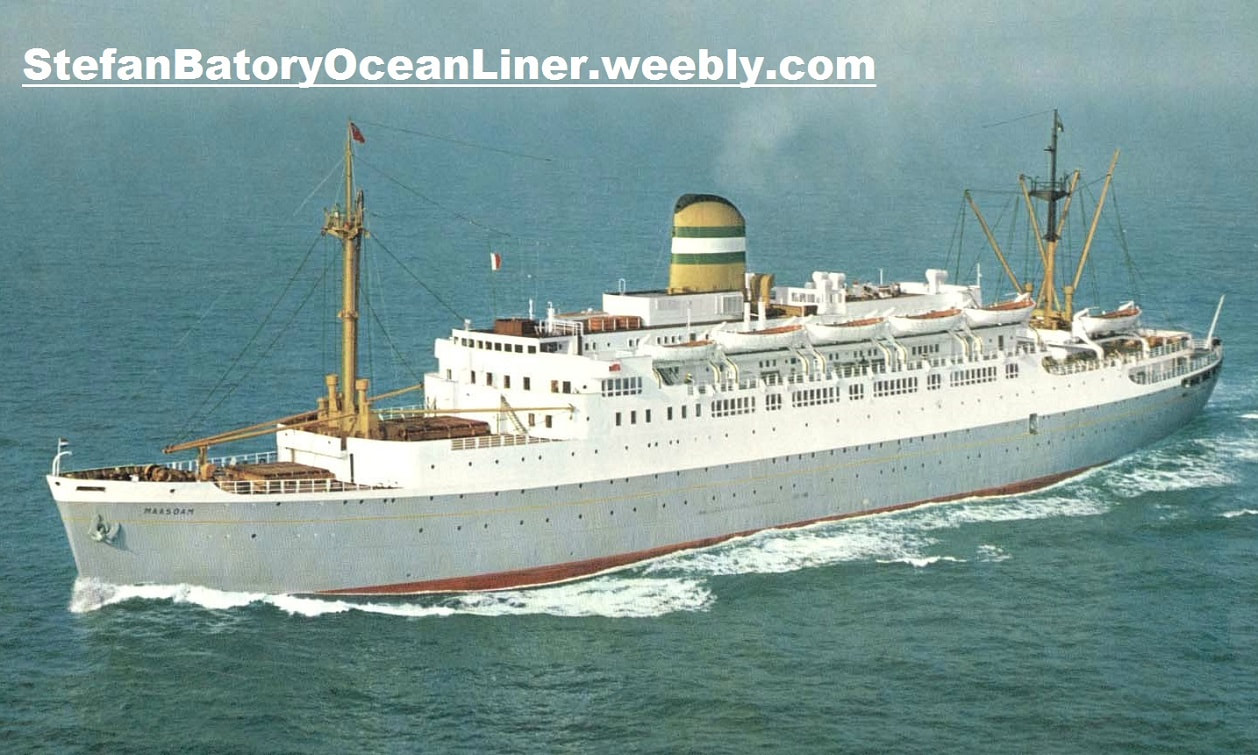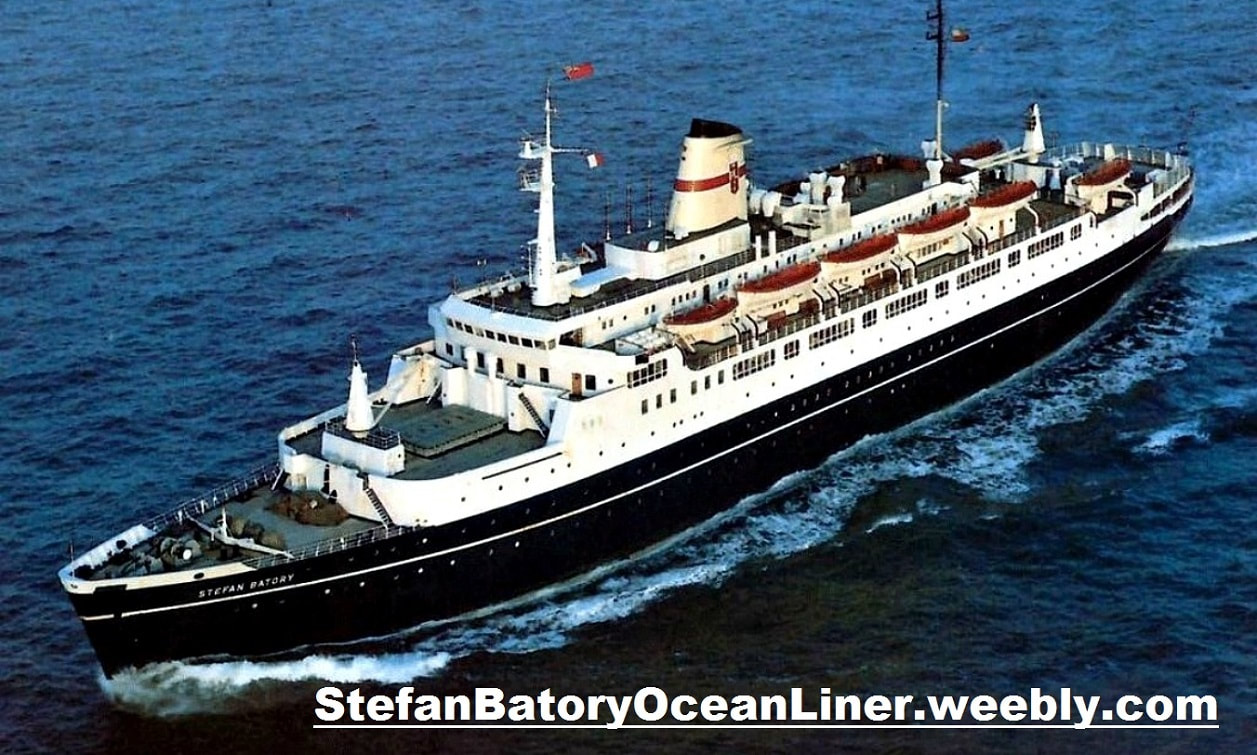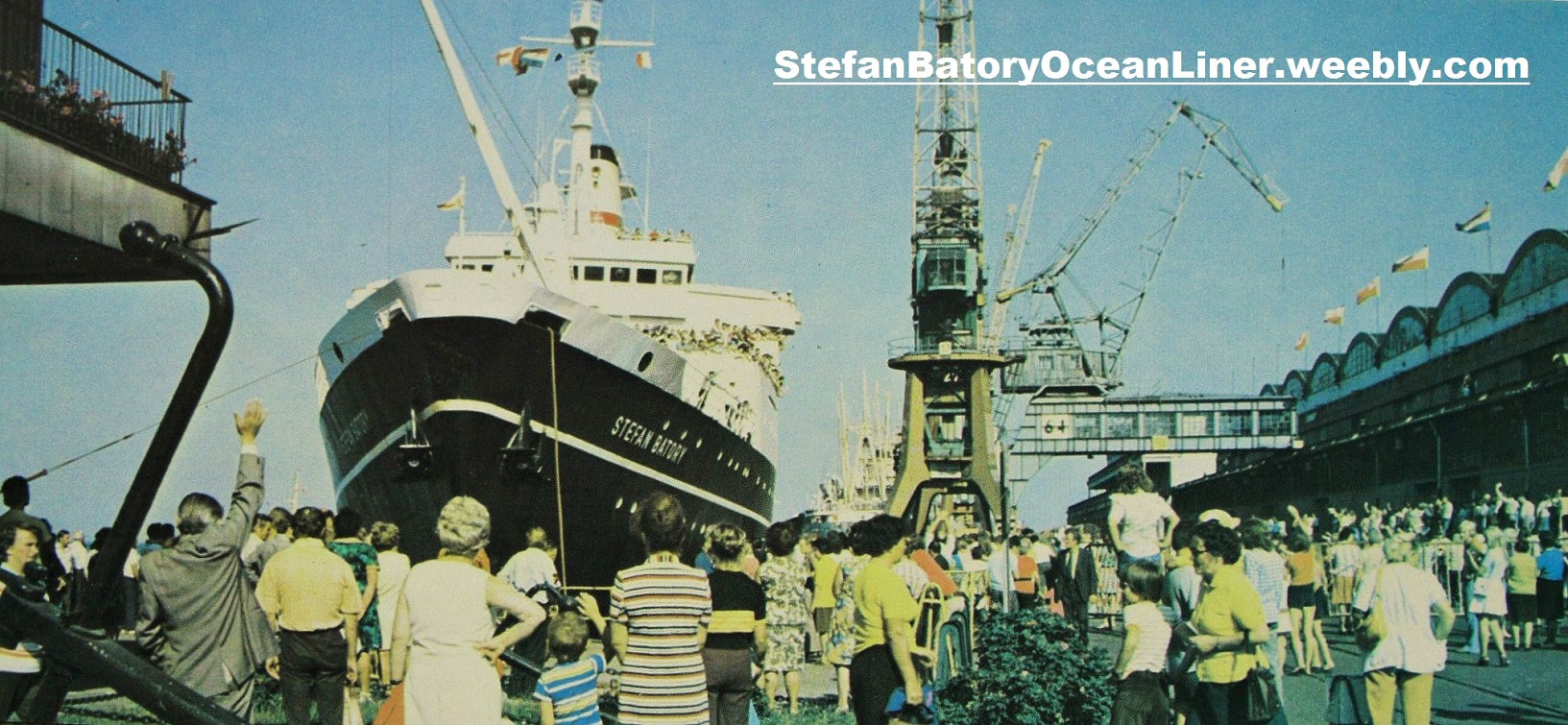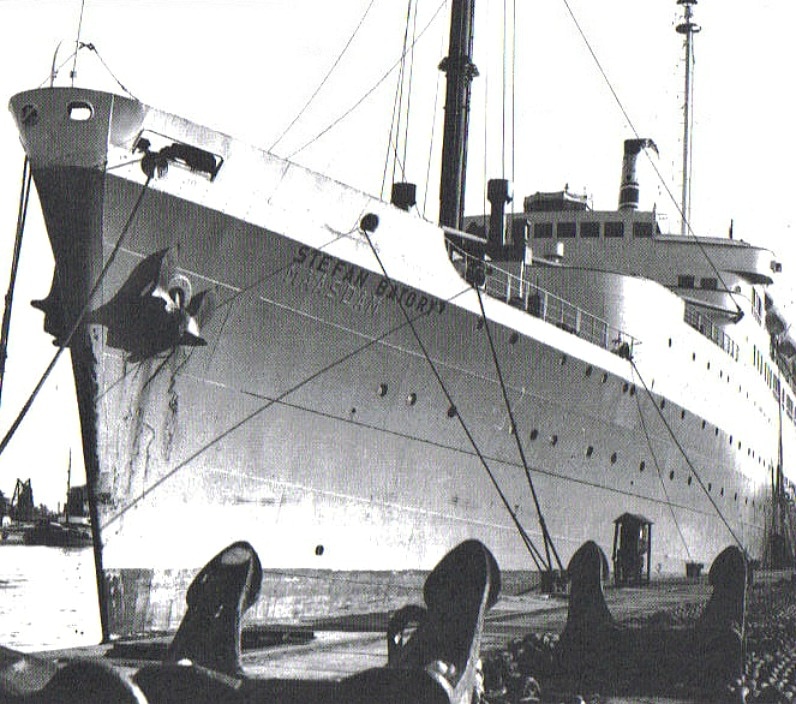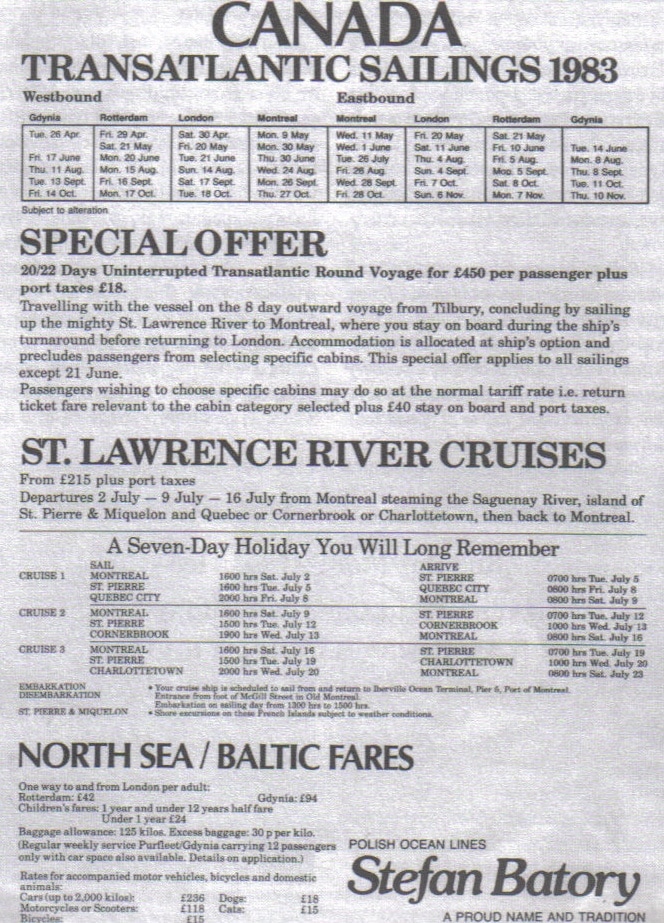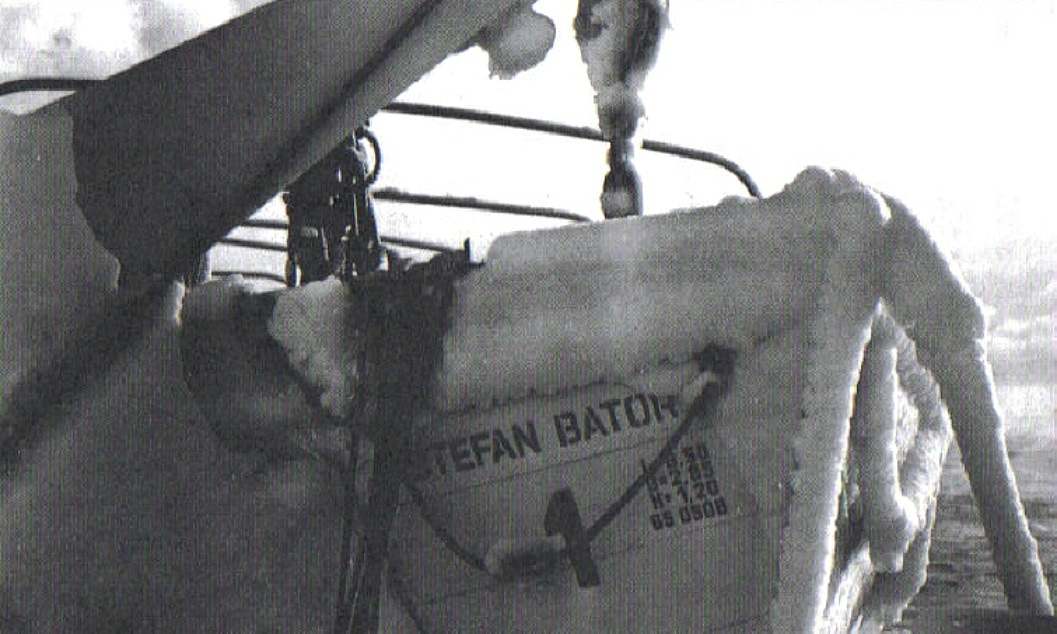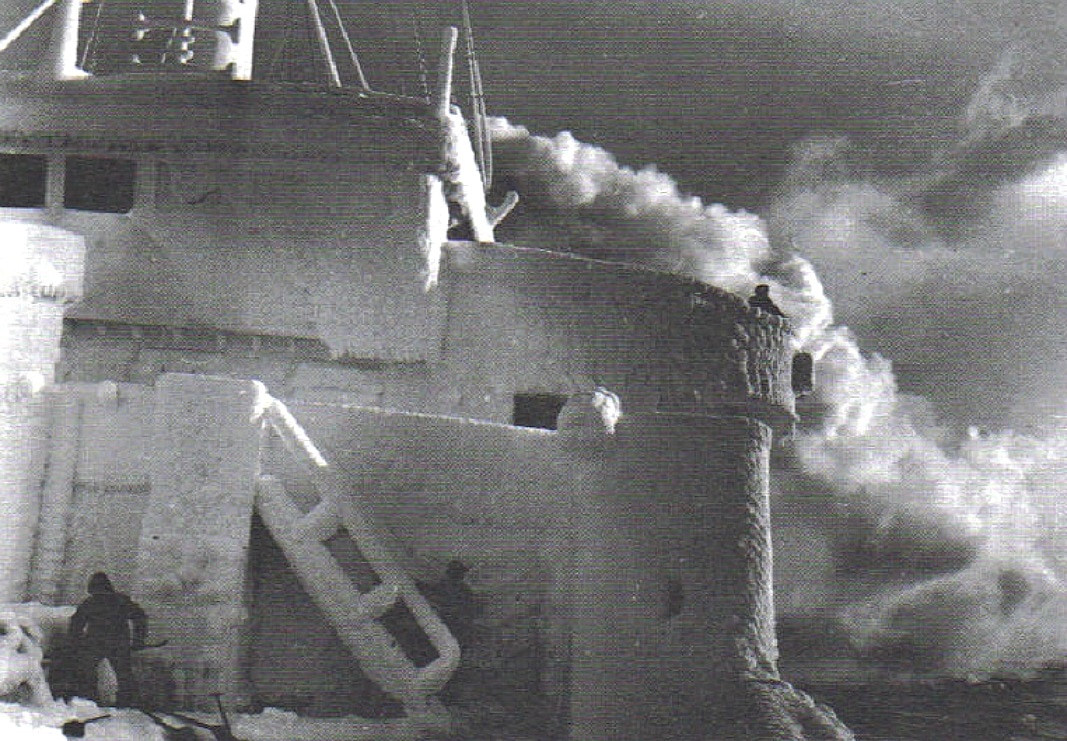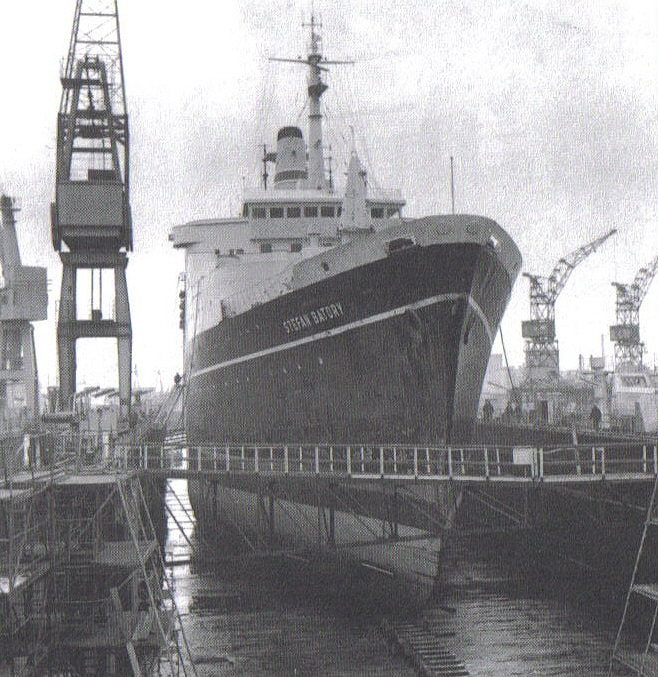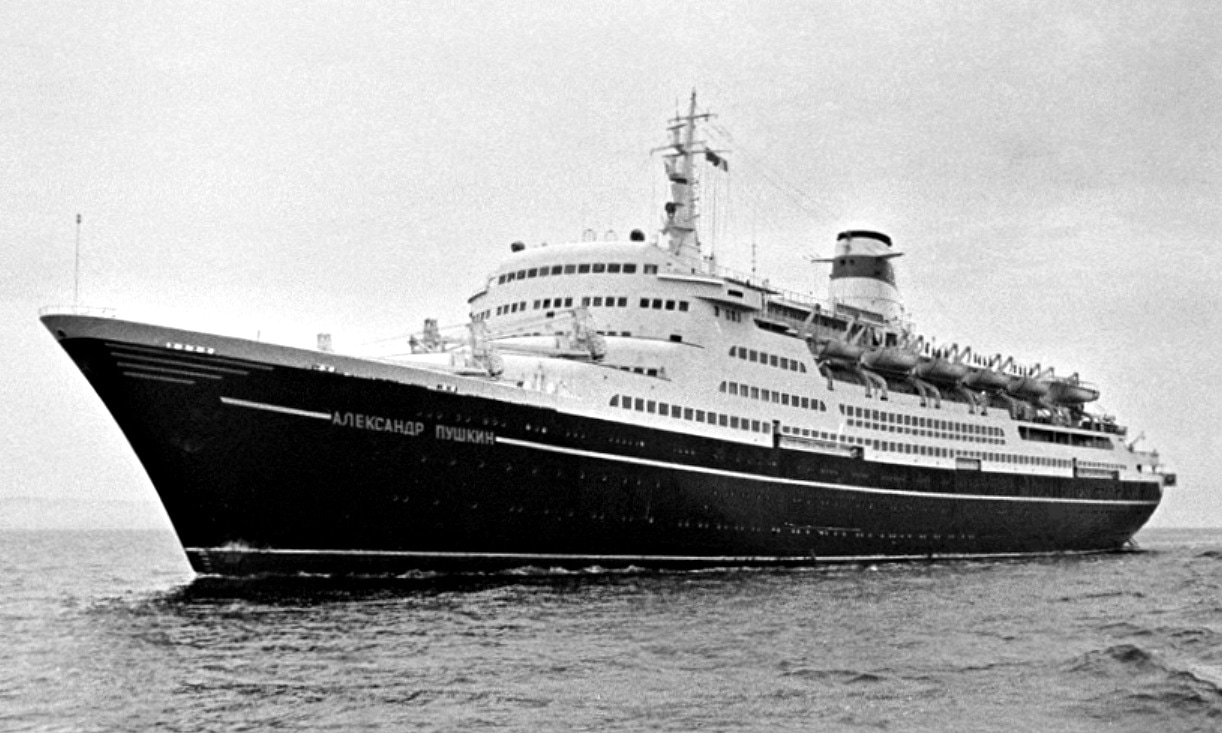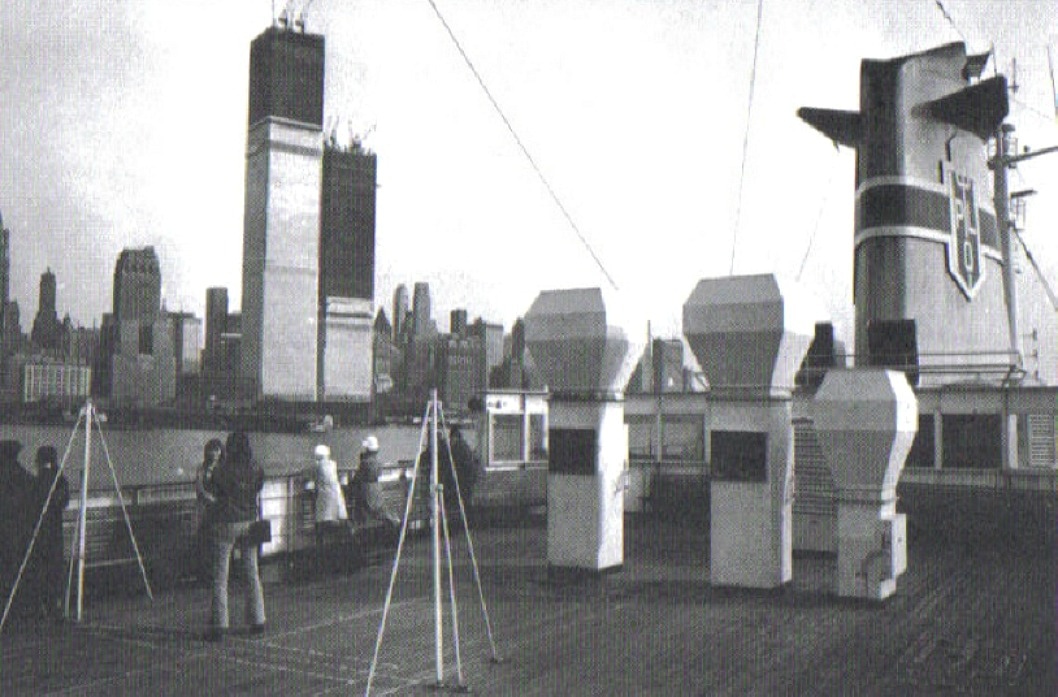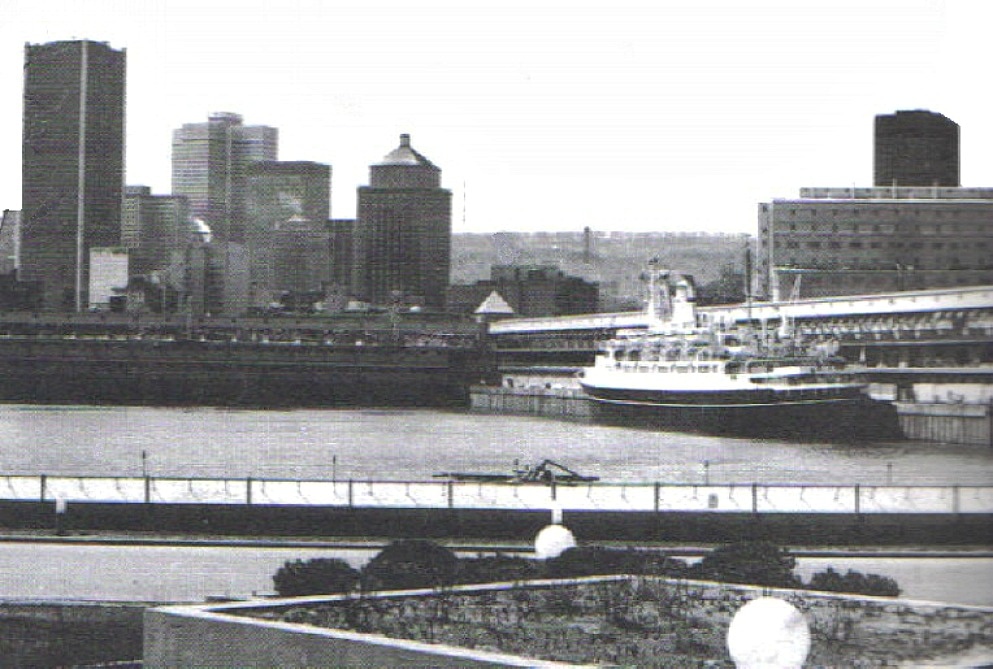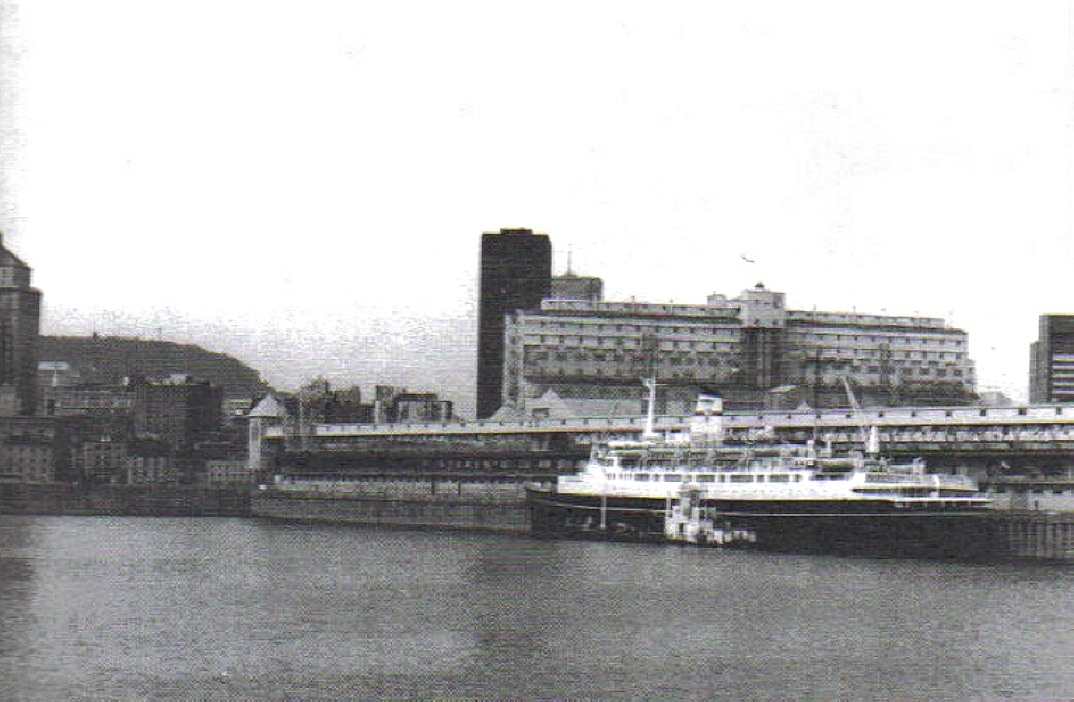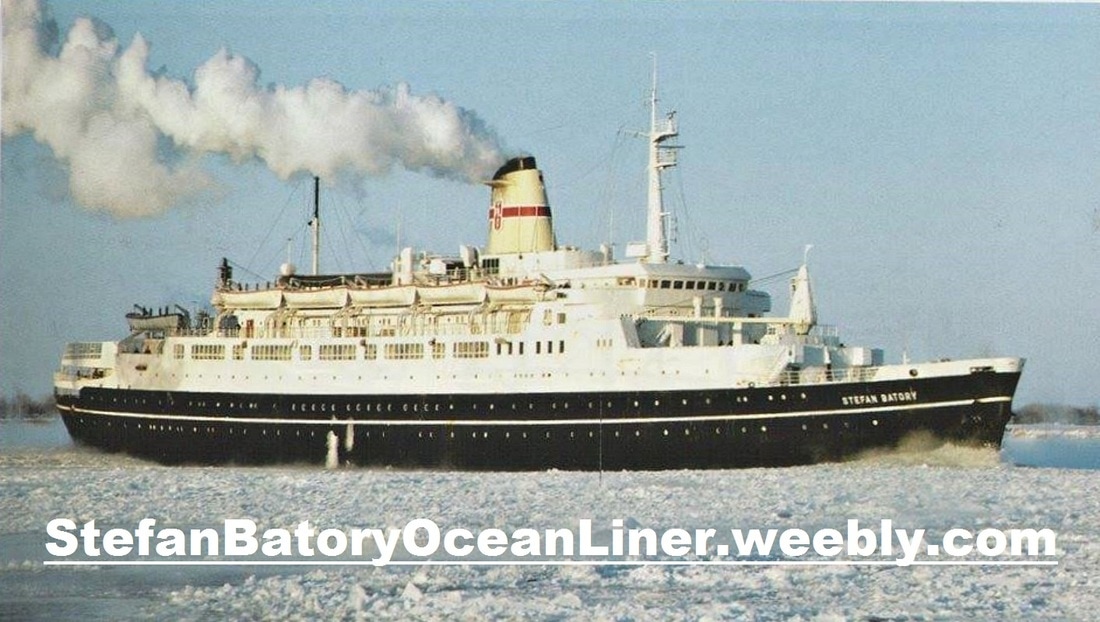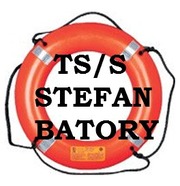HISTORY OF THE SHIP/ DZIEJE STATKU
|
TS/S MAASDAM, 1952-68 in original colors of the Holland America Line, later renamed TS/S STEFAN BATORY, 1968-88
TS/S MAASDAM 1952-68 w sluzbie Holand America Line, pozniej przemianowany na TS/S STEFAN BATORY, 1968-88 |
TS/S STEFAN BATORY 1968-88 (ex. TS/S MAASDAM 1952-68) after refitting in the Polish shipyard in Gdansk,1969
TS/S STEFAN BATORY po remoncie w Gdanskiej Stoczni - gotowy do wojazy pod polska bandera, 1969 |
TS/S STEFAN BATORY at the homeport Gdynia, Poland in late 70's
TS/S STEFAN BATORY w Gdynskim Porcie, lata '70
TS/S STEFAN BATORY w Gdynskim Porcie, lata '70
|
TS/S MAASDAM (1952-68)... beginning in Holland The North Atlantic's 'Great Liners' are usually thought of in terms of size and speed. Yet, many of the most innovative and influential ships have been of moderate dimensions. More pace-setting than pretentious were Allan Line's VICTORIAN and VIRGINIAN of 1905 (first turbine powered liners) and GRIPSHOLM of 1925, the pioneer Atlantic motorliner. In 1951-52 Holland America Line introduced two ships unremarkable in size and speed yet, by virtue of their accommodation arrangement, revolutionary. By giving Tourist Class virtual 'run of the ship' the RYNDAM and MAASDAM were among the most influential and successful liners ever built. Holland Amerika Lijn N.A.S.M. (Holland America Line) recovered quickly from the devastation of the Second World War. As early as June 1946, the New York service had been re-opened with the new passenger-cargoliner WESTERDAM followed by NOORDAM and the refitted VEENDAM. The return of the flagship NIEUW AMSTERDAM in October 1947 was an emotional symbol that Holland America was 'back'. In 1948, their 75th anniversary, H.A.L. ordered the first of a projected trio of 60 passenger cargoliners for their North Pacific service from Wilton-Fijenoord's Schiedam yards. The first, DIEMERDYK, entered service in 1950 and her sister, slated to be DINTELDYK, was laid down as Yard #732 on 17th December 1949. Meanwhile, Atlantic traffic was showing unprecedented strength with a heavy demand for Tourist berths for which the postwar 'combo' liners were ill-suited. The replacement of the aging 1922/3 VOLENDAM and VEENDAM took on a new urgency. Rather than design and build new ships from scratch, H.A.L. decided to redesign DINTELDYK as a liner and immediately lay down a sister ship. On 30th October 1950 the Line's Director Willem H. de Monchy announced in Rotterdam that DINTELDYK would be renamed RYNDAM (II) and enter service on the Rotterdam-Channel Ports-Southampton-New York run that following summer with a sister named MAASDAM (IV) coming in 1952. Both ships would introduce a revolutionary two-class layout favoring Tourist. This idea came about, it is told, when Director de Monchy's daughter (married to a former Canadian officer and living in Canada) wrote her father bemoaning the high costs of passage to Europe. The MAASDAM was laid down at Schiedam as Yard #733 on 19th December 1950. Exactly a year later, RYNDAM was christened by Mrs. C. Tjarda van Stakenborgh Stachouwer-Marburg, wife of the prewar Governor-General of the Dutch East Indies. Although announced she would introduce a new dove grey hull livery, RYNDAM was painted the traditional black with white stripe at launching. With up to 1,000 men working on her fitting-out, the new ship was ahead of schedule and in May 1951 her maiden voyage was changed to 16th July instead of 16th August. After trials in the English Channel, RYNDAM was handed over to HollandAmerica on 10th July. On the 16th the new ship left Rotterdam's Wilhelminakade bound for New York via Le Havre (Northern France) and Southampton (Southern England). The RYNDAM's maiden arrival at Southampton on 17th July 1951 and at New York on the 25th caused more than the usual interest. Heralding a veritable armada of new ships in the 'fifties, she introduced many new features. The grey hull livery with a gold riband was new to the fleet and her funnel, too, was an innovation. Initial drawings of the ship showed a conventional NOORDAM style funnel. However, it was decided to give her the new Strombos Aerofoil first fitted on the French liner PRESIDENT DE CAZALET in April 1950. The wafer thin Strombos reduced wind resistance with the slipstream carrying-away the smoke. At 15,015 grt, with an overall length of 503 feet and beam of 69 feet, RYNDAM and her sister were compact with a large superstructure atop a hull of freighter dimensions. Overall, the profile was more solid than sleek with the sturdy hull and stocky cargo masts imparting a business-like quality. Usually, the focus of attention was First Class but the RYNDAM's most intriguing aspect was her Tourist Class. For the first time on the Atlantic, Tourist passengers had virtual run-of-the-ship instead of being relegated to the least desirable areas. The RYNDAM turned old conventions completely around with a token First Class for 39 berths (to satisfy the two-class requirement of the Trans-Atlantic Passenger Steamship Conference) secluded on Boat Deck. Such innovation was nothing new to H.A.L. - in 1938 NIEUW AMSTERDAM was first with private facilities in all Cabin (First) Class staterooms and the 'combo' liner NOORDAM had all facility cabins. This time innovation benefited the economy passenger with RYNDAM's remaining decks (Promenade, Main, 'A' and 'B"' the domain of Tourist Class. HollandAmerica had created an amazing vessel from a freighter's hull. First Class had fifteen outside double staterooms with private bath or shower. Public rooms were limited to a cozy Lounge forward and Dining Saloon aft on Boat Deck. It was telling that when RYNDAM came alongside H.A.L.'s Hoboken, New Jersey pier for the first time, First Class was only 55% occupied (mostly with officials) whilst Tourist had but 33 empty berths. It was for these budget travelers that she was designed and built. Tourist Class public rooms on Promenade Deck comprised a large 'Palm Court' forward, suitably done in light woods, bamboo and greenery; a Card Room, Library, a snug 'American Bar' and Smoking Room aft. Young passengers enjoyed one of the nicest playrooms afloat aft on Boat Deck which doubled as a Veranda Cafe on cruises. The Dining Room, amidships on 'A' Deck, featured some attractive examples of marquette. The decor was attractive but the spaciousness was the innovation. The 854 Tourist passengers were accommodated in six single-berth, 28 triples, 56 four-berth cabins and a then remarkable 63% in two-berth cabins. These were entirely air-conditioned but 'compact' and largely inside with washbasin only but public facilities were ample and convenient. Everything was typically Dutch; neat, pleasant and practical. Both ships were also designed to cruise in the 'off-season' with an outdoor pool aft on Promenade Deck and 20,000 sq. ft. of deck space. The MAASDAM, launched on 5th April 1951 by Mrs. Adriaan Gips, was handed over to N.A.S.M. on 10th August 1952. Like her sister (the two were almost identical except for decor), MAASDAM was delivered early and was to have made her first trip on 24th September. Her maiden voyage from Rotterdam on 11th August to New York was via Le Havre and Southampton with a special call at Montreal on the 20th. This was arranged in recognition of the ever-friendly ties between Canada and the Netherlands', the role of the Royal Canadian Army in the liberation of Holland and the large numbers of Netherlanders who emigrated to the Dominion. Indeed, most of her 880 passengers landed at Montreal. She continued to New York via the Cape Cod Canal; one of the largest ships to transit the waterway. New York welcomed MAASDAM on 27th August; the last of three new Atlantic liners in 1952 - preceded by UNITED STATES and FLANDRE. Heralded as 'The Economy Twins', RYNDAM and MAASDAM arrived at the crest of the postwar wave in steamship travel. With Tourist passage starting at 59 ($160), they were outstandingly successful. During her first year, MAASDAM averaged 85% capacity on crossings and 96% on cruises. On these, 550 one-class passengers were carried to the Caribbean, Bahamas and Bermuda. The low fares were derived from economical operation. They retained the freighter machinery of two cross-compound General Electric steam turbines (built in 1945) developing 8,500shp double-reduction geared to a single screw. The service speed was only 16.5 knots with an eight day run from Britain to New York but the daily fuel consumption was just 53 tons. Offering 'Comfort with Economy' each had only 228 stewards, limited menus and uncomplicated cuisine. Both developed a 'Friendly Ship' reputation appealing to budget vacationers, students, professors, emigrants, artist and cultural groups. The RYNDAM and MAASDAM were innovations in budget travel whose success was emulated by Greek Line's OLYMPIA and Cunard's SAXONIA class. 'The Economy Twins' sailed between Rotterdam, Le Havre, Southampton with frequent calls at Cobh en route to New York running with NIEUW AMSTERDAM, NOORDAM and WESTERDAM. The MAASDAM soon displayed an unfortunate propensity for bumping into things. Outbound in fog in the Nieuw Waterweg (linking Rotterdam with the Hook of Holland) she collided with and sank the 268 ton German tanker ELLEN on 10th December 1952. Six of tanker's crew were lost although MAASDAM was undamaged. Eastbound on 3rd October 1954 she struck the freighter TOFEVO in thick fog off Rhode Island. The MAASDAM's stem was crumpled and the two ships returned to New York. There was a further embarrassment when some 200 passengers angered at H.A.L.'s refusal to pay hotel and meal bills whilst the ship was repaired, staged a 'sit-down' strike. The passengers won their point and MAASDAM sailed on 27th October. Also in the mid-fifties the ship hit the Wilhelminakade, damaging her bow above the waterline. With their bulky superstructures and short hulls, both ships could pitch heavily. In 1954 the Royal Dutch Navy designed a fin-like device that was fitted to RYNDAM's bow. On trials in the North Sea the fins caused her stern to swing so wildly they had to be removed in dry dock at Southampton. A more conventional approach was taken during MAASDAM's 1955 overhaul when she was the first H.A.L. ship fitted with Denny Brown stabilizer fins and her sister was equipped the next year. Indicative of RYNDAM and MAASDAM's success, HollandAmerica ordered from Wilton-Fijenoord in November 1955 a larger and faster 19 knot, 21,000 tonner which entered service in June 1957 as STATENDAM. Unlike the earlier pair, 90% of STATENDAM's Tourist cabins had private facilities. In July 1958 RYNDAM began regular calls at Galway, Ireland. In September 1959 the new flagship ROTTERDAM entered service, introducing a horizontal arrangement giving each class its own complete decks. With STATENDAM and ROTTERDAM on the New York run, H.A.L. opened a regular Rotterdam-Le Havre-Southampton-Quebec City-Montreal service with RYNDAM's 30th March 1960 sailing to Quebec City with the next voyage on 29th April proceeding to Montreal. In winter RYNDAM called instead at Halifax and occasionally Boston. She also inaugurated Canadian cruises with a 15 day voyage from Montreal on 26th July to Saguenay, Gaspe, Bermuda, New York and Quebec City. By 1961 even budget travelers expected more luxury and MAASDAM and RYNDAM had a block of cabins amidships on Main Deck rebuilt with private shower and toilet, reducing Tourist capacity to 822 berths. The First Class Lounge was extended on the starboard side adding a 'Gents' Corner bar. The MAASDAM's run was extended to Bremerhaven in 1963 but her first call on 15th February was rather unfortunate. In dense fog, she was off the Weser Lightship en route to a welcoming ceremony at the Columbus Quay. Among the 230 passengers were 150 invited guests and the Royal Dutch Marine Band. At 8:05am she struck the wreck of the British freighter HARBOROUGH which herself had rammed the sunken Soviet KHOLMOGORY in 1959. Shifting ice-floes had moved the marker buoys. A ten foot gash was torn into MAASDAM's hull and she developed a twelve degree list. The passengers were lowered in lifeboats and picked up by the Weser pilot steamer. There were no injuries and MAASDAM limped into port and repaired at Nordeutschen Lloyd Werft, missing two voyages. Her first Bremerhaven-Rotterdam-Le Havre-Southampton-Galway (alternatively Cobh)-New York voyage departed on 16th April. The last sailing that year proved almost as eventful; on 22nd December an ice coated MAASDAM docked at New York two days late with 200 passengers (and 18,000 sacks of Christmas post!) after encountering 35 foot seas, snow, ice and sleet driven by 75 mile an hour winds. The MAASDAM was still very much an Atlantic mail-boat. That year, H.A.L.'s New York terminus was relocated to Pier 40 in Manhattan ending a long association with Hoboken. By 1964, the Atlantic run was well into its final decline with seaborne passengers down to 17% from the 50% just seven years previously. HollandAmerica embarked on a series of changes for 'The Economy Twins'. With the withdrawal of the Royal Rotterdam Lloyd-Nederland round-the-world service operated by WILLEM RUYS and ORANJE, H.A.L. tried to fill the gap, during the winter. The RYNDAM was dispatched from Rotterdam on 7th November 1964 on an 'experimental voyage' to Southampton, Suez, Fremantle, Melbourne, Sydney, Wellington, returning on 30th January 1965 via the Pacific coast and the Panama Canal with 860 one-class passengers. On 20th October 1965 MAASDAM sailed Rotterdam-Southampton-Port Said-Colombo-Fremantle -Melbourne- Sydney -Wellington-Papeete-Los Angeles-Acapulco-Balboa-Cristobal-Kingston-New York-Cobh-Southampton -Rotterdam. These voyages met with some success against the faster P&O-Orient mailships. To make her more suitable for longer voyages, RYNDAM arrived at Norddeutschen Lloyd Werft in Bremerhaven on 3rd December 1965 for a two month refit. This included a new cinema-theatre for 280 on 'D' Deck in the forward hold, a launderette, and a new bar in the Lounge. On 6th February 1966 RYNDAM departed Rotterdam on what would prove her final H.A.L. world voyage although MAASDAM continued the service for two more seasons. More changes were in store for RYNDAM and MAASDAM with rising losses because of a devalued guilder, inflation and the high labour costs of their Dutch crews. In early 1966 it was decided to transfer RYNDAM to H.A.L.'s German flag subsidiary Europa-Kanada Linie GmbH of Bremen (renamed that year E.C.L. Shipping Co.) replacing SEVEN SEAS, a converted American C3 class freighter used for low-cost student voyages. The RYNDAM's last Montreal sailing was on 20th August 1966. Re-registered in Bremen, her buff funnel was given a green band with white diamonds. Her Dutch officers and crew were replaced by lower salaried Germans. The RYNDAM departed on her first student voyage, Bremerhaven to New York on 8th October. On the 20th she sailed on her first round-the-world student cruise chartered to Chapman College of Orange, California. On these, she was one-class with self-service in the dining room. Between her extended 'floating university' cruises, she made Atlantic crossings for various student organisations. The MAASDAM, which had on occasion 'filled-in' on the St. Lawrence run, was transfered to that service upon her 12th October 1966 sailing to Montreal. The RYNDAM's career under the German flag was short-lived. Apparently N.A.S.M. were unhappy with the ship's management (including accidental damage to a boiler) and profits. On 28th August 1967 she was transferred to another affiliated company, the Dutch flag Scheepvaart Maatschappij Trans-Ocean. Like Europa-Kanada, Trans-Ocean had specialised in student and migrant traffic with their 'Three Constellations'; ZUIDERKRUIS, WATERMAN and GROOTE BEER (see 'SM' January 1986). The RYNDAM replaced this trio after her final crossing for E.C.L. from Bremerhaven on 29th September 1967. Arriving at Pier 40 on 9th October, she sported Trans-Oceaan's narrow red-white-blue funnel bands and with Dutch officers and crew. Her duties remained the same, sailing on another ChapmanCollege world cruise on 11th October. It had been intended to give her a 'Constellation' name, WATERMAN (Dutch for 'Aquarius') but this waited until the completion of this cruise. Back at Pier 40 on 24th May 1968 she was renamed, sailing the next day on the first of seven voyages to Southampton and Rotterdam for the Netherlands Office for Foreign Student Relations. To confuse things a bit more, H.A.L. retook control of the vessel on 10th October which reverted to her original name and livery. The RYNDAM, however, continued her student cruises and did not again feature in H.A.L. schedules. The MAASDAM's final world voyage was from 7th January - 3rd April 1968. That season's Canada sailings maintained a load factor of 85% in the absence of Cunard and Canadian Pacific down to two 'Empresses'. Only the Eastern Block lines were expanding; the Soviets introduced the new ALEXANDR PUSHKIN in 1965 and Polish Ocean Lines were planning to replace the thirty-year-old BATORY. Coinciding with a re-trenching of N.A.S.M.'s trans-Atlantic service, the Poles were looking at 'used' tonnage having shelved ambitious plans for new ships. The search led to MAASDAM and on 15th May 1968 came the surprising announcement that she had been sold for 'better than book value' to Polish Ocean Lines with handing over at the end of her final N.A.S.M. Atlantic season. Twelve planned winter cruises from Southampton were cancelled. On 20th September MAASDAM departed Montreal on her last crossing under Dutch colors and was paid-off at Rotterdam on the 29th. TSS MAASDAM renamed as TSS STEFAN BATORY TS/S STEFAN BATORY inherited a national and Atlantic tradition on 11th April 1969 when she sailed from her homeport of Gdynia on her maiden voyage calling at Copenhagen on the 12th, Tilbury (14th), Quebec City (22nd) and arriving at Montreal on the 23rd. Her first eastbound crossing departed on 25th April. The initial route was Gdynia-Copenhagen-Tilbury-Quebec City-Montreal-Southampton-Copenhagen-Gdynia with the first season's nine voyages averaging a 93% load factor. This popularity stemmed in part from P.O.L.'s considerable ethnic Polish trade (7 million people of Polish ancestry live in North America) and there was yet no direct air service from Poland. She also attracted a loyal non-Polish following, building on the reputation of the old BATORY. That ship was finally retired in mid-May 1969 so for two months, P.O.L. had both a BATORY and a STEFAN BATORY in service together! From mid-December 1969 to March 1970 STEFAN BATORY underwent the second stage of her refit at Gdansk. This included fitting the bubinga wood 'Little Lounge' with modern furniture and carved wood panels and the cherry wood Library received amber light fixtures and new furnishings. The Smoking Room became the Night Club and the Card Room was uniquely transformed into 'The Polish Inn' and 'Mountaineer's Cottage' with rustic pine paneling and decking. On Main Deck, off the Foyer, a block of cabins was replaced by a new Card Room and Chess Room whilst aft on Promenade Deck, a gymnasium and sauna were added. In place of the forward hold, a 280 seat cinema was constructed. Crew accommodation was improved and an automatic fire detection system installed according to the 1966 regulations. The ship had taken on a new decorative character that was, like her profile, a pleasant combination of the old and new. Left intact from MAASDAM are the American Bar with its dark walnut panelling, the Tourist Dining Room and the First Class rooms on Boat Deck. This includes the Bar-Lounge overlooking the bows. Paneled in Zeelandelm and Italian walnut, it is one of the most evocative shipboard rooms. Externally, a glass windscreen was fitted around the outdoor pool. Starting her second season, the former MAASDAM renewed old ties on 11th April 1970 with Rotterdam which was now a regular call with HollandAmerica as agents. With her sister finding renewed popularity as an Atlantic liner, RYNDAM sailed on as student ship. In 1969 four Le Havre -Southampton-New York voyages were followed by a world cruise. The next June, she made two Boston-Cherbourg-Southampton crossings under charter to the Foreign Study League of Salt Lake City, Utah. A further charter was cancelled and the ship laid up at Schiedam. Returning to service on 9th October she introduced, for the first time in a H.A.L. ship, Indonesian stewards. With ever rising costs however, her days under the Dutch flag were numbered. The RYNDAM's tenth and final 'campus afloat' cruise for ChapmanCollege departed Los Angeles on 1st February 1971 taking 503 American students on a four month voyage ending in New York on 21st May. The friendly little RYNDAM had introduced thousands of young people to the pleasures of an ocean voyage and the unique education of travel. Her 'floating university' role had been highly successful and prompted C.Y. Tung's purchase of QUEEN ELIZABETH for conversion as SEAWISE UNIVERSITY. That dream did not die with that great ship in flames in Hong KongHarbour and was reborn when the ex-American Export ATLANTIC made her first cruise as UNIVERSE CAMPUS in September 1971. At the time of RYNDAM's last cruise, it was reported she had been sold to Sovereign Cruises of Malta for Mediterranean 'fly-cruises' for the British market. The sale fell through and RYNDAM arrived at her builders on 1st June 1971 and laid-up. On 18th August 1972 she was sold to World Wide Cruises SA (Panama) of the Greek Epirotiki Line for $2.5 million. During an eight-month rebuilding in Greece, RYNDAM was radically transformed into TSS ATLAS, 'a Titan of Cruising Pleasure'. Except for the Boat Deck cabins, the old accommodation was replaced by more spacious, private facility cabins. In some cases, as many as three of the original cabins were made into one. Additional cabins were added in the former public bathroom, playroom, crew and cargo areas. Thus, the total capacity of the 289 cabins was 731 (568 double occupancy), not much less than STEFAN BATORY. The public rooms were entirely redone with the Palm Court, renamed the 'The Esperides', doubled in size with an extension forward, the Library became the Shopping Gallery and the Smoke Room was now a pool bar. The new decor was on ancient Mediterranean themes by Epirotiki's interior designer Maurice Bailey and artist Arminio Lozzi employing original mosaics, tapestries, murals and sculpture. An additional outdoor and indoor pool were added. The RYNDAM disappeared under an orgy of sheetmetal; flaring, 'ski-jump' masts and other typically 'seventies nonsense. Her bow was given a raked stem and the funnel (built around the original one) ranks as one of the most bizarre a float. The STEFAN BATORY, like her predecessor, was often in the news politically. When the St. Lawrence was ice-bound, crossings were made to/from New York and on 4th January 1971 she was the first Communist Block liner to dock there since BATORY in 1951. Her 397 passengers and 337 crew were greeted by longshoremen who picketed the vessel at Pier 40 saying she 'floated in a sea of blood' (referring to the recent Gdansk riots) and refused to unload her cargo (she carried none). Unruffled, she sailed on the 6th with only 120 passengers and returned, with less notoriety on 19th March with 761 aboard. However, six planned Caribbean cruises from New York that winter were cancelled for lack of bookings. Then there were the well publicized defections: 81 Poles jumped ship in Hamburg in January 1974 and at the same port, 192 left the ship in November 1984. It was all indicative of Poland's domestic conditions, belied by the non-political 'Old World' atmosphere maintained aboard (see 'SM' October 1981). With EMPRESS OF CANADA's withdrawal in 1971 the Canadian run was down to STEFAN BATORY and ALEXANDR PUSHKIN which was larger, faster and newer but nowhere as popular. That year, the Polish flagship averaged 92% load factors whilst the Soviet liner had but 49%. The STEFAN BATORY's trans-Atlantic routine changed somewhat over the years. Starting in 1972 she began to call at Germany, first Cuxhaven and then Hamburg. The long-established Copenhagen call ended in 1975 and those at Quebec a year later when she also became one-class with berths for 779 passengers. In 1977 the frequent stops at Hamburg and Southampton (eastbound) were trimmed to a regular Gdynia-Rotterdam-Tilbury-Montreal run. With the demand for 'off season' travel down, Atlantic round voyages were reduced to six by 1977 in favor of cruising. As a result, her 11th and last New York departure was on 17th March 1976 and because of new environmental regulations, she can no longer call at US ports. In 1980 ALEXANDR PUSHKIN was withdrawn making STEFAN BATORY the only ship trading to Canada and with QUEEN ELIZABETH 2, the last two Atlantic liners. An older vessel, she also was one of the last remaining passenger ships with a high number of staterooms without private bathroom facilities. Whilst maintaining her Atlantic crossings STEFAN BATORY evolved into a successful cruise ship. In 1975 she sailed from Tilbury on a New Year's and 'Southern Cruise' to the Canary and AtlanticIslands. The next year, she started a yearly 'Christmas-New Years Cruise'. Summer St. Lawrence and SaguenayRiver cruises from Montreal began in 1978. The next year's highlight (24th February - 17th April) was her epic 52-day Mediterranean/Black Sea cruise which called at 22 ports. In 1980 she introduced a one-month West Indies cruise and August 1986 made her first Norwegian Fjords cruise from Tilbury. Although STEFAN BATORY catered to the usual cruise travelers, Polish workers often sailed on her as a reward for high productivity in the homeland. The Solidarity Movement in Poland and resulting declaration of martial law in December 1981 affected STEFAN BATORY whose homeport was a center of the quasi-revolution that August. Many sailings terminated in Rotterdam instead of Gdynia. The 1981 Christmas and 1982 Caribbean cruises had to be cancelled. New restrictions greatly reduced the number of Polish passengers. Despite all the problems, it was reported in 1982 that the Poles were planning to replace STEFAN BATORY in late in 1986 with a new ship, either built in Poland as POLONIA or in Finland or West Germany and named BATORY. As with similar plans to build new ships twenty years previously, these came to nothing due to political and economic problems. The veteran liner carried on, symbolic of the indomitable spirit of the Polish people. The first crossing of the 1982 season (marking the 25th anniversary of the Gdynia-Canada run and STEFAN BATORY return to service after lay-up), from Rotterdam to Montreal in late April. In mid-Atlantic, news was received that QUEEN ELIZABETH 2 had been 'called-up' for the Falklands War. The Polish flagship was the sole Atlantic liner and in much demand. The extra business was needed - we had only 230 aboard due to the unrest in Poland. Whilst some QE2 passengers were wary of sailing in 'that Polish boat', many came away preferring the classic STEFAN BATORY to the Cunarder's cruise ship ambiance. Whilst one cannot find a violin aboard QE2, one may still take tea in STEFAN BATORY's 'Grand Lounge' to the strains of Lehar, Strauss and Kriesler. There is no 'Magrodome' but one can still laze in a wood deck chair on the teak enclosed promenade. With the Cunarder's conversion to diesel-electric, STEFAN BATORY is now the only steamship on the Atlantic. The once revolutionary vessel is now a bastion of tradition. During 20 years of service there were many best Polish artists on aboard performing and entertaining STEFAN BATORY's passengers. On many occasions the ship was considered as a greatest "ambassador" of Polish culture and tradition to the world. By 1985 STEFAN BATORY had completed 131 Atlantic voyages carrying 180,259 passengers and taken 86,049 passengers on 136 cruises. Impeccably maintained, supremely reliable and staffed by nicest crew afloat, the 35-year-old ship will soon play her last polonaise. Faced with a major survey in 1988, unable to comply with Canadian environmental regulations and with Poland's economic troubles, it was made known in January 1987 that she will be withdrawn without replacement next March. Last of the classic Atlantic liners, the STEFAN BATORY is making four round voyages to Montreal this season. The final voyage, from Gdynia on 22nd September, arrives at Montreal on 5th October. She bids adieu to Canada on the 7th and arrives home on the 20th. This will sadly mark the last regularly scheduled trans-Atlantic crossing under steam, the last to Canada and ends 57 years of Polish trans-Atlantic service begun with the POLONIA on 14th August 1930. Like the M/S BATORY, the TS/S STEFAN BATORY's career concluded with a series of cruises. In addition to two Norwegian fjord trips this summer, the ship performed two long winter cruises from Tilbury. The first, 7th Nov - 4th Jan 1988, was the first South American voyage by a Polish liner since M/S SOBIESKI and CHROBRY in 1939 and included calls at Rio de Janeiro, Santos, Montevideo and Buenos Aires. The TS/S STEFAN BATORY's last voyage was a 'West Indies/Cuba' cruise sailing from Tilbury on 17th January and returning on 22nd March. After the Polish colours are lowered for the last time, the TS/S STEFAN BATORY has got a place in the maritime history of her nation and in the hearts of her officers, crew and passengers.Like the M/S BATORY, she was Poland's Pride. After the TS/S STEFAN BATORY retirement by Polish Ocean Lines, she was operated by the Hellenic Polish Line, then sold to Stena A/B and her name shortened to TS/S STEFAN. She was briefly served as an refugee accommodation ship / hostel in Gothenberg, Sweden (1990-92). Plans to completely rebuild her into a modern cruise vessel were shelved in the early 1990's, and the graceful little liner (with many of its original Holland America Line paneling and fittings still in place) was left to rot. After nearly 8 years in layup at Chalkis (Greece), and prior to that several years idle between Gothenburg and Eleusis, STEFAN arrived at the Aliaga, Turkey shipbreakers on March 22, 2000. As of mid-April, all furniture had been removed and the scrapping process had claimed her bow, leaving the superstructure intact. The total demolition took about five months. (...) Toronto, Aug 3, 2000 CREDITS The majority of the above information based on the article by PETER C. KOHLER published in the British magazine "SHIPS MONTHLY", Oct. 1987. Other Sources: "Maritime Matters", "Ksiega Statkow Polskich"- J. Micinski, B. Huras, M. Twardowski, "The Great Luxury Liners-Web Site", "Krolewski Statek Batory"- J. Pertek,"Varsity-Ocean Liners" by Ch. Paolino, "Unofficial Holland Americfa Line Home Page", "Rocznik Gdynski"- J. Kortylewski. Interviews with crew members by author of this web site: capt. Jerzy Pszenny, officer Emil Piechowicz & others. PHOTOS: Album "Transatlantyki Polskie" - Jerzy Drzemczewski, Tadeusz Slebioda. Thank you! |
TS/S MAASDAM IV (1952-68)... poczatek w Holandii W 1949 Holendrzy postanowili wybudowac na bazie ameykanskich kadlubow typu C3 (transportowce wojskowe) dwa blizniacze statki na potrzeby towarowo-wojskowe. W trakcie budowy plany zmieniono i w 1952 zwodowano oba statki jako pasazerskie o nazwie RYNDAM i MAASDAM IV (pozniejszy STEFAN BATORY). Weszly one do sluzby w HollandAmerica Line i byly eksploatowane w regularnych rejsach do USA, a potem takze do Indii, Australii i pomiedzy portami Europy. Oba statki o pojemnosci 15,044 ton kazdy, dlugosci 153 m i szybkosci 16,5 wezla, nie wyroznialy sie niczym szczegolnym pod wzgledem technicznym, aczkolwiek byly nowoscia na owczesnym rynku zeglugi pasazerskiej poprzez zdecydowane sprofilowanie ich standartu na klase turystyczna. Bylo tam tylko 15 dwuosobowych kabin pierwszej klasy z wlasnymi lazienkami. Reszta pasazerow (854) podrozowala w kabinach klasy turystycznej, ktore posiadaly tylko umywalki. TSS MAASDAM poplynal na swoj dziewiczy rejs 11 sierpnia '52 do Nowego Jorku poprzez Le Havre (Polnocna Francja), Southampton (Poludniowa Anglia) i Montreal (Wschodnia Kanada). Byl to statek oferujacy 8 dniowa podroz z Europy do Ameryki tanio i wygodnie. Nie bylo tam wyszukanej obslugi i ekstrawaganckiego jadlospisu. Bylo jednak funkcjonalnie, czysto i tanio. Porzez przystepne ceny podrozowali na jego pokladzie urlopowicze, emigranci, studenci i artysci. W polowie lat '50, srednio 85% miejsc bylo zajetych na rejsach przez Atlantyk i 96% na rejsach wycieczkowych. W poczatkowej fazie swojej morskiej kariery MAASDAM mial pecha co do kolizji; W 1954 zderzyl sie on we mgle z francuskim statkiem uszkadzajac sobie dziob. Pozniej, w trakcie rejsu do Bremerhaven (Polnocne Niemcy), 15 lutego '63, zszedl z toru wodnego (zniesiony przez lody) i rozprul sobie dno o wraki dwoch zatopionych statkow, angielskiego HARBOROUGH i sowieckiego KHOLMOGORY. Ze statku ewakuowano do lodzi ratunkowych ok. 500 pasazerow, a statek powedrowal do stoczni na dwa miesiace. Pod koniec 1964 popularnosc transatlantyckich rejsow zaczela gwaltownie spadac, jako ze coraz bardziej popularny stawal sie transport lotniczy. Holland America Line musialo zmodifikowac rejsy MAASDAM. Ograniczono transatlantyckie wojaze na rzecz rejsow wycieczkowych, ktore zaczely cieszyc sie coraz wiekszym powodzeniem. 20 pazdziernika '65 wyslano MAASDAM z turystami w podroz dookola swiata ( Rotterdam, southhampton, Port Said, Colombo, Fremantle, Melbourne, Sydney, Wellington, Papeete, Los Angeles, Acapulco, Balboa, Cristobal, Kingston, New York, Cobh, Southhampton, Rotterdam ). Potem byly kolejne rejsy wycieczkowe, aczkolwiek nie staly sie one wielkimi sukcesemi. W 1968 Holendrzy sprzedali MAASDAM IV za ok. 3 miliony dolarow Polskim Linia Oceanicznym, ktore potrzebowaly znalezc nastepce dla polskiego transatlantyka M/S BATORY, ktory mial wowczas juz ponad 32 lata. Polacy mysleli o zbudowaniu nowego statku jako nastepcy BATOREGO, ale ze wzgledow finansowych zdecydowano sie na zakup jednostki uzywanej. TSS MAASDAM przemianowany na TSS STEFAN BATORY TSS MAASDAM IV przekazany zostal Polskim Linia Oceanicznym 8 pazdziernika '68. Przemianowany na TS/S STEFAN BATORY, przyplynal do Gdyni pod dowodctwem kapitana Jerzego Pszennego. W Gdanskiej Stoczni Remontowej STEFAN BATORY przeszedl, w dwoch etapach, gruntowna przebudowe (listopad '68 / kwiecien '69 - grudzien '69 / marzec '70). Wiazala sie ona ze zmiana sylwetki, kolorow, wymiana wielu urzadzen, mebli, instalacji przeciwpozarowych. Podczas modernizacji zmieniono ksztalt komina, zlikwidowano toporne maszty towarowe i zastapiono je elektrycznymi dzwigami. Zainstalowano nowe maszty na unowoczesnionej sterowni i gornym pokladzie. Biblioteka otrzymala nowe, bursztynowe oswietlenie, Palarnia zostala przeksztalcona w NIght Club, a Salon do gry w karty zamieniony zostal na Polski Zajazd i Goralska Chate. Wydluzono Poklad Spacerowy i urzadzono tam Saune z mala Sala Gimnastyczna. Likwidujac pewna liczbe kabin na Glownym Pokladzie stworzono nowy Salon do gry w karty i szachy. Wygospodarowano takze miejsce na kino z 280 miejscami. Kabiny dla zalogi zostaly unowoczesnione, a niewielki basn kapielowy na rufie otoczony zostal szklanym wiatrochronem. Po calej przebudowie, statek prezentowal sie dostojnie - laczyl tradycje z umiarkowana nowoczesnoscia. Zabieral wowczas 766 pasazerow w klasie turystycznej i 39 w klasie pierwszej. STEFAN BATORY wyplynal w swoj dziewiczy rejs z Gdyni do Montrealu 11 kwietnia '69 ( Gdynia, Copenhagen, Tilbury, Quebec City, Montreal ). W pierwszym roku STEFAN BATORY wykonal 9 rejsow do Ameryki przy ponad 90% wysprzedanych miejsc. Ta niezwykla popularnosc wynikala z faktu ze w Ameryce Polncnej mieszka ponad 7 milionow ludnosci pochodzenia polskiego. Poza tym, w koncu lat '60 Polska nie miala bezposredniego polaczenia lotniczego przez Atlantyk. STEFAN BATORY przyciagal rowniez pasazerow, kierujacych sie w swoim wyborze dobra reputacja i legenda poprzednika BATORY, ktory ze wzgledu na swoj wiek zostal wycofany ze sluzby w maju 1969. STEFAN BATORY, podobnie jak jego poprzednik, byl czesto zwiazany z roznymi incydentami politycznymi... 4 stycznia '71, STEFAN BATORY przyplynal do Nowego Jorku jako pierwszy komunistyczny liniowiec od czasow BATOREGO, ktory byl tam w 1951. Pasazerowie (397) i zaloga (337) zostali przywitani, przy Doku numer 40 przez pikietujacy tlum prezentujacy wymowny napis "Przyplynales w morzy krwi". Bylo to zwiazane z krwawo stlumionym protestem polskich robotnikow stoczniowych przeciwko nedzy i rzadowi komunistycznemu w Polsce (Gdansk - grudzien 1970). Amerykanie odmowili rozladowania i obslugi statku. Niechciany w Nowym Jorku, STEFAN BATORY wyruszyl w rejs powrotny do Polski tylko ze 120 pasazerami, 6 stycznia / 71. Wrocil do Nowego Jorku 19 marca '71 z 761 pasazerami przy mniejszej fali protestow. Jakkolwiek, 6 planowanych rejsow karaibskich, wlasnie z Nowego Jorku, zostalo odwolanych z braku chetnych. Kilka lat pozniej , w styczniu '74, gazety podaly wiadomosc o 81 Polakach, ktorzy zeszli ze STEFANA BATOREGO w Hamburgu, szukajac w Niemczech Zachodnich azylu politycznego. W listopadzie '84, w tym samym porcie, z tych samych powodow zeszlo ze statku 192 Polakow. Powyzsze wydarzenia byly oczywista kompromitacja dla komunistycznego rzadu w Warszawie i odbiciem trudnej sytuacji polityczno - ekonomicznej w Polsce. Na poczatku lat '70, po wycofaniu z rejsow EMPRESS OF CANADA, regularne polaczenie Europa - Canada utrzymywane bylo tylko przez STEFANA BATOREGO i sowiecki liniowiec ALEXANDR PUSHKIN, ktory byl wiekszy, szybszy i nowszy, aczkolwiek daleko mniej popularny niz statek polski. W okresie tym STEFAN BATORY utrzymywal srednio wskaznik 92% sprzedanych miejsc, a sowiecki liniowiec tylko 49%. Trasa Atlantycka STEFANA BATOREGO byla modyfikowana kilkukrotnie. Poczawszy od 1972, w drodze do Ameryki, zaczal on zawijac do dwoch niemieckich portow, Cuxhaven i Hamburga ( Polnocne Niemcy). Wizyty w Kopenchadze zakonczyly sie w 1975, a w rok pozniej liniowiec polski omijal takze Quebec City. Swoj ostatni rejs do Nowego Jorku, STEFAN BATORY odbyl 17 marca 1976. Ze wzgledu na zaostrzone, nowe przepisy dotyczace ochrony srodowiska naturalnego nie mogl on dluzej zawijac do portow USA. Docelowym portem, po drugiej stronie Atlantyku stal sie Montreal w Kanadzie. W 1977 wycofano sie z regularnego zawijania do Hambura i Southhampton . Poczawszy od roku 1977 trasa STEFANA BATOREGO zostala okrojona do czterech portow: Gdynia, Rotterdam, Tilbury, Montreal. W zwiazku ze spadkiem zapotrzebowania na rejsy transatlantyckie, liczba ich zostala ograniczona do 6 w 1977. Zwiekszono jednak liczbe rejsow wycieczkowych. Gdy w 1980 wspomniany wczesniej ALEXANDR PUSHKIN zostal wycofany ze sluzby, STEFAN BATORY i QUEEN ELIZABETH 2 byly dwoma ostatnimi Atlantyckimi Liniowcami. W polowie lat '70, utrzymujac regularne rejsy transatlantyckie STEFAN BATORY przeksztalcil sie sie w stosunkowo dobrze prosperujacy statek wycieczkowy. W 1975, odbyl on Noworoczny rejs z Tilbury (Londyn) na Wyspy Kanaryjskie, ktory zapoczatkowal tradycje rejsow Swiateczno-Noworocznych w latach nastepnych. W 1978 rozpoczal regularne rejsy wycieczkowe z Montrealu po rzece Sw. Wawrzynca, a w 1979 poplynal w 52-dniowy rejs po morzu Srodziemnym i Czarnym odwiedzajac 22 porty. W 1980 odbyl on miesieczny rejs na Karaiby a w sierpniu 1986 poplynal z Tilbury na pierwszy rejs po Norweskich Fjordach. Zaznaczyc trzeba ze w okresie tym wielu polskich "przodownikow pracy" spedzalo urlopy na STEFANIE BATORYM bedace nagroda za ich "wysoko wydajna prace" w socjalistycznej ojczyznie. Narodziny Niezaleznego Zwiazku Zawodowego SOLIDARNOSC i wynikajace z niego zmiany w Prawie Morskim (1981) wplynely na losy STEFANA BATOREGO, ktorego macierzysty port Gdynia-Gdansk stal sie centrum rewolucyjnych zmian w zyciu polityczno-spolecznym. W zwiazku z trudna sytuacja w kraju, wiele rejsow zaczynalo i konczylo sie w Rotterdamie zamiast w Gdyni. Swiateczno-Noworoczny rejs w 1981 oraz rejsy po Karaibach w 1982 zostaly odwolane. Restrykcje polityczne spowodowaly drastyczne zredukowanie liczby polskich pasazerow. Jednak w tym samym czasie donoszono, ze wladze planuja zastapic STEFANA BATOREGO nowym statkiem w koncu 1986. Miala to byc jednostka o nazwie POLONIA, zbudowana w polskiej stoczni lub w stoczni Finlandzkiej, ewentualnie Niemieckiej i noszaca nazwe BATORY. Podobnie jak 20 lat wczesniej, plany te nie zostaly zrealizowane w zwiazku z trudnosciami polityczno-ekonomicznymi. STEFAN BATORY - liniowiec weteran, pozostawal wiec nadal w sluzbie. W 1982, obchodzono 25 rocznice polaczenia transatlantyckiego Gdynia-Montreal, a takze powrot STEFANA BATOREGO do regularnych rejsow, po kilku miesiecznym przestoju w porcie. Pierwszy rejs z Rotterdamu do Montrealu, odbyl sie w koncu kwietnia. W okresie tym, brytyjski liniowiec QUEEN ELIZABETH 2 zostal skierowany, jako transportowiec, do wziecia udzialu w Wojnie na Falklandach. STEFAN BATORY byl wiec w tym czasie jedynym liniowcem na Atlantyku. Po modernizacji QUEEN ELIZABETH 2 na statek z napedem dislowskim, polski liniowiec stal sie takze jedynym turbinowym parowcem na Atlantyku - bastionem zeglugowych tradycji. Przez ponad 20 lat w sluzbie PLO, STEFAN BATORY goscil na swoim pokladzie wielu najlepszych polskich artystow. Uatrakcyjniali Oni swoimi wystepami kolejne rejsy. Przy wielu okazjach uwazano statek za szczegolnego "ambasadora" polskiej kultury i tradycji. Na pokladzie STEFANA BATOREGO zostalo nakreconych takze kilka polskich filmow fabularnych. Z koncem 1985, polski liniowiec mial na swoim koncie 131 Atlantyckich wojazy, przewozac 180,259 pasazerow, wyplynal na 136 rejsow wycieczkowych zabierajac 86,049 pasazerow. Byl znakomicie utrzymywany i obsadzany zawsze najlepsza zaloga. Aczkolwiek, ze wzgledow techniczno - finansowych, statek ten nie mogl podolac rosnacym wymagania Kanadyjskich Przepisow Ochrony Srodowiska Naturalnego. W styczniu 1987 bylo wiadomo ze zostanie on wycofany ze sluzby w marcu 1988. Ostatni z klasycznych Atlantyckich Liniowcow, STEFAN BATORY odbyl cztery rejsy do Montrealu w 1987. Ostatni wojaz z Gdyni do Montrealu odbyl sie jesienia '87 (22 wrzesien - 5 pazdziernik). Wrocil do Gdyni 20 pazdziernika '87. Byl to koniec ery regularnych rejsow transatlantyckich dokonywanych przez parowce, a takze koniec 57 letniej tradycji rejsow przez Atlantyk pod polska bandera, ktore zostaly zapoczatkowane przez statek S/S POLONIA, 14 sierpnia 1930. Podobnie jak poprzednik, STEFAN BATORY zakonczyl swoja kariere seria rejsow wycieczkowych; Fjordy Norweskie (lato'87), Ameryka Poludniowa (7 listopad - 4 styczen '88) i Karaiby / Kuba (17 styczen-22 marzec '88). Szczegolnym rejsem byl wojaz do Ameryki Poludniowej, gdzie polski statek pasazerski zawital pierwszy raz od czasow M/S SOBIESKI i M/S CHROBRY w 1939. Trasa wiodla przez Rio de Janerio, Santos, Montevideo i Buenos Aires. Po wycofaniu ze sluzby w Polskich Liniach Oceanicznych, TS/S STEFAN BATORY zostal sprzedany greckiemu przedsiebiorstwu, a jego nazwa zostala skrocona do TS/S STEFAN. W latach 1990-92 sluzyl jako hotel dla uchodzcow w szwedzkim porcie Gothenberg. Jego wnetrza, w dalszym ciagu posiadaly wiele oryginalnych paneli i wykonczen z czasow sluzby w Holland America Line. Plany przebudowania STEFANA na nowoczesny statek wycieczkowy zostaly zaniechane w 1990. Po prawie 8 latach przestoju w greckim porcie Chalkis, 22 marca 2000, przeholowano STEFANA do Tureckiej Stoczni Zlomowej w Aliaga, gdzie zostal poddany zlomowaniu trwajacemu 6 miesiecy. TS/S STEFAN BATORY znalazl szczegolne miejsce w historii zeglugi pasazerskiej, ale takze w sercach swoich oficerow, zalogi i tysiecy pasazerow. Podobnie jak M/S BATORY, stal sie polska duma. (...) Toronto, sierpien 3, 2000 Wiecej szczegolow na temat dziejow STEFANA BATOREGO mozna znalezc w czesci angielsko-jezycznej widocznej obok. VIDEO: TSS STEFAN BATORY I MS BATORY - Doc. Film, TVP ZRODLA Powyzsze informacje pochodza glownie z opracowania autorstwa PETER C. KOHLER opublikowanego w brytyjskim magazynie "SHIPS MONTHLY", pazdziernik 1987. Pozostale zrodla: "Krolewski Statek Batory"- J. Pertek, "Ksiega Statkow Polskich"- J. Micinski, B. Huras, M. Twardowski, "The Great Luxury Liners-Web Site", "Varsity Ocean Liners"- Ch. Paolino, "Unofficial Holland America Line Home Page", "Rocznik Gdynski"- J. Kortylewski, "Maritime Matters-Web Site", rozmowy autora tej witryny z czlonkami zalogi; kapt. Jerzym Pszennym, oficerem Emilem Piechowiczem i innymi. FOTO: Album "Transatlantyki Polskie" - Jerzy Drzemczewski, Tadeusz Slebioda... 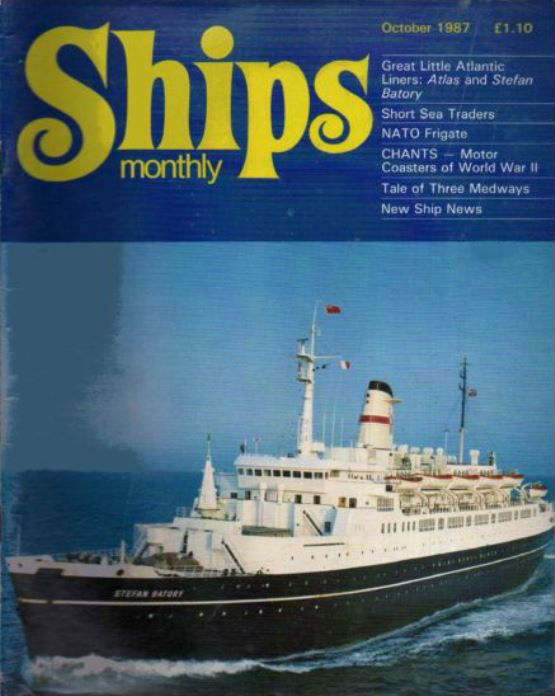
The cover of the British magazine "Ships Monthly", Oct 1987, where the maritime historian Peter C. Kohler published his extensive article regarding history of the TSS STEFAN BATORY/ Okladka brytyjskiego magazynu "Ships Monthly" z pazdziernika 1987, gdzie marynista Peter C. Kohler opublikowal swoj obszerny artykul o historii TSS STEFAN BATORY.
|
TS/S STEFAN BATORY - the begining of the long career - Polish Shipyard Gdansk, 1969
TS/S STEFAN BATORY - poczatek morskiej kariery - Stocznia Gdanska, 1969
ALTERNATIVE LINK - CLICK HERE
TS/S STEFAN BATORY - poczatek morskiej kariery - Stocznia Gdanska, 1969
ALTERNATIVE LINK - CLICK HERE
|
TS/S STEFAN BATORY in her last transatlantic voyage "Gdynia-Montreal-Gdynia" - documentary film, Oct. 1987
TS/S STEFAN BATORY w filmowej relacji ze swojego ostatniego transatlantyckiego rejsu "Gdynia-Montreal-Gdynia". W rejsie tym, statkiem dowodzil kpt. Hieronim Majek - pazdziernik 1987 |
A brief interview with cpt. Hieronim Majek after the last transatlantic voyage was completed - Oct. 1987
Wypowiedz kpt. Hieronima Majka, ktory dowodzil TS/S STEFAN BATORY w ostatnim transatlantyckim rejsie z Gdyni do kanadyjskiego Montrealu i z powrotem - pazdziernik 1987 |
